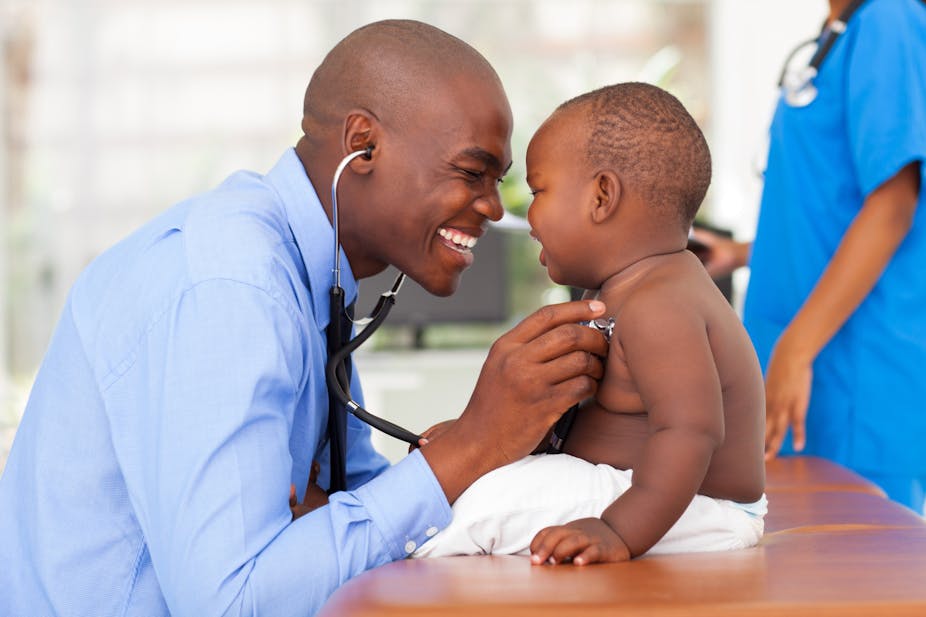It is more than 20 years since the South African constitution first guaranteed children’s “right to basic health care services”. This is part of a broader commitment to ensure children’s rights to optimal survival, health and development. The question is how close South Africa is to realising these rights in practice.
We address this issue in a chapter of the South African Child Gauge 2019 report.
Unlike adults’ right to health, children’s right to basic health care services is not subject to progressive realisation. Children should therefore be prioritised within the health care system. Yet the state has still not defined an essential package of health care services for children. This makes it difficult to determine what they are entitled to and what the state should be held accountable for.
Without a defined package, there’s a danger that the drive for efficiencies and cost saving may result in a limited basket of care that doesn’t address the complex needs of children. This is particularly true for those with chronic (long term) health conditions.
This essential package of care needs to be supported by a set of norms and standards. These need to specify the infrastructure, equipment, medicines and staff needed to meet the unique needs of children and adolescents. A clear package will also make explicit how health care establishments need to be equipped. These would include neonatal and paediatric wards as well as emergency medical services and primary health care services, where children currently have to compete for attention with sick and injured adults.
In other facets of the health system, too, budgets, building of infrastructure and medicine supplies need to consider children’s unique needs.
A child rights approach to health requires health professionals to treat children and their caregivers with respect and communicate effectively. Health care providers also need to build children’s and adolescents’ capacity to take responsibility for their own health and include them in decision making.
These fundamental shifts in the balance of power between adult and child, doctor and patient have been found to relieve pain and suffering. They also improve diagnosis, compliance with treatment, patient satisfaction and health outcomes.
Training health workers
The United Nations Committee on the Rights of Child has called for children’s rights to be integrated in the curriculum and performance criteria of all professionals working with children. These include health and allied professionals, teachers and social workers. The aim is to ensure that they are better attuned to children’s needs and rights.
For example, the LinCARE programme, where a team of health workers provides mother and child health care in Limpopo province, aims to reduce neonatal mortality. It does this by improving the quality of care during pregnancy and labour. The programme is aimed at ensuring that all women have a positive pregnancy and birth experience. It includes antenatal classes and ensures that women have practical and emotional support from a birth companion and kind, respectful and technically competent clinical staff.
As part of current preparation for a national health insurance system, which is aimed at extending universal health care to all South Africans, bolstering the primary health care system offers three opportunities to strengthen the child health workforce and improve the quality of care:
Community health workers play a central role in bringing health care services close to home, particularly for children living in poor or remote households. It’s therefore encouraging to see the national department of health’s commitment to employing them and paying them the minimum wage. This should improve supervision and support and ensure greater continuity of care between community-based services and health care facilities.
School health teams are another essential ingredient of the child system, helping to screen older children and address barriers to learning. Yet coverage reaches only one third of pupils in their first year of schooling and 20% of grade 8 learners. Its effectiveness is compromised by the shortage of health and other social service professionals, such as social workers, oral hygienists and dentists, psychologists, physiotherapists, speech and language therapists and occupational therapists.
Finally, district clinical specialist teams provide essential leadership for child and adolescent health at district level. For example, neonatal mortality has dropped by 30% in districts where there are paediatricians and paediatric nurses, yet less than half of specialist teams have a full paediatric team.
What needs to be done
The progress for child health has been uneven in South Africa with significant variation between provinces and districts. For example, immunisation varied from 90% in Mpumalanga to 69% in the Eastern Cape – signalling persistent inequities in access and coverage of care.
Given these challenges, greater investment is needed to strengthen systems and build a workforce for child and adolescent health. National health insurance provides an important opportunity to ensure universal health coverage and financial risk protection for the poor, as well as to improve the quality of care.
This requires leadership for child health at every level of the health care system – from individual encounters with children and their families, to ensuring that child health is adequately represented on key decision-making structures that will decide how resources are allocated.
Very importantly, it requires that the health sector works with and alongside other sectors. Interventions such as sufficient good quality food, good quality education, safe water and sanitation, good housing, safe roads and safe communities can significantly promote the health and well-being of children.
The South African Child Gauge 2019 report is published by the Children’s Institute at the University of Cape Town. The theme of the 2019 issue – “Child and adolescent health: leave no one behind” – is a call to prioritise child and adolescent health and put children at the heart of the health care system.
Lori Lake, a co-editor of the Child Gauge report, also contributed to this article.

